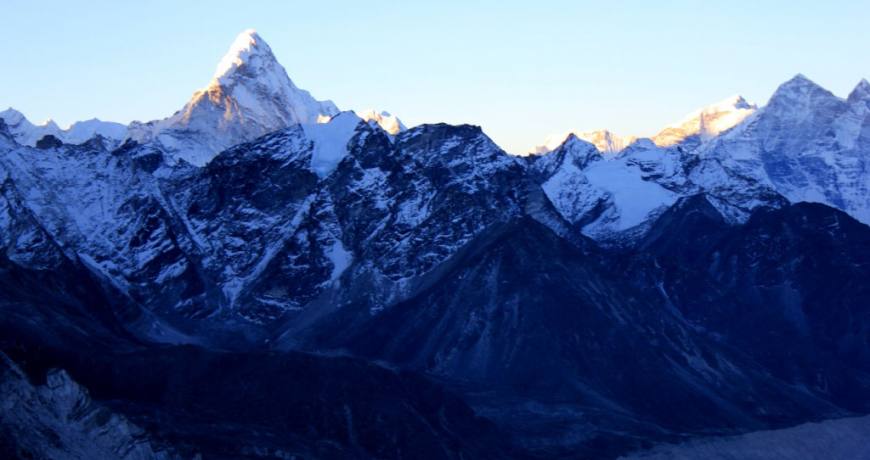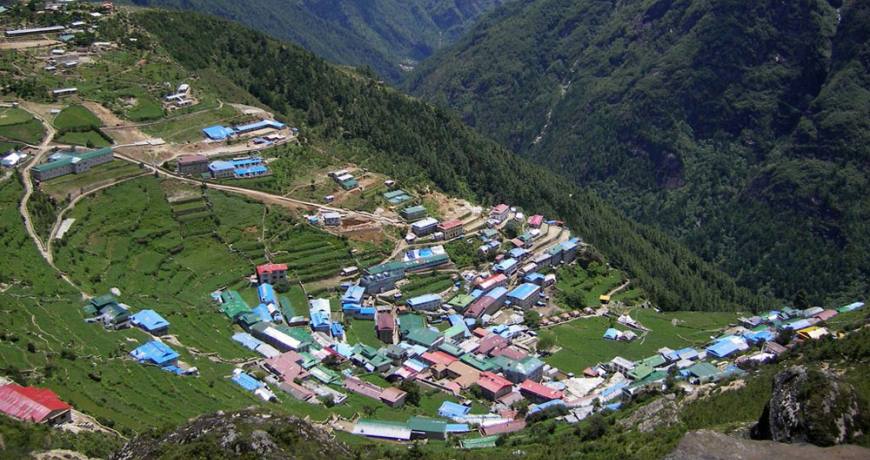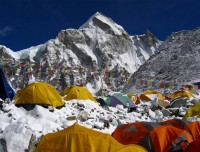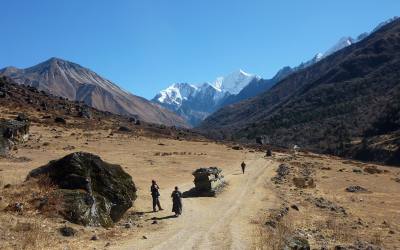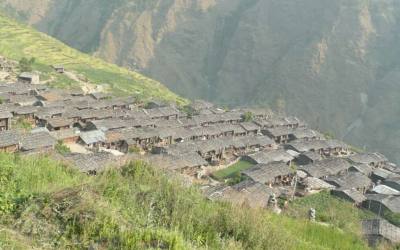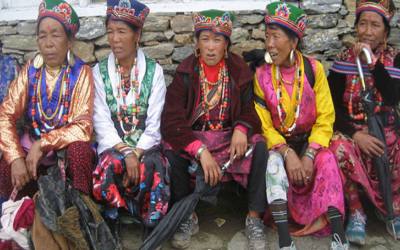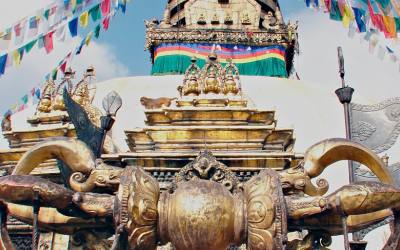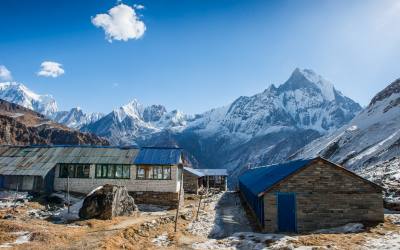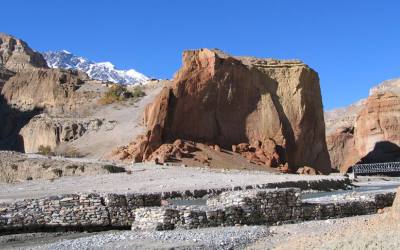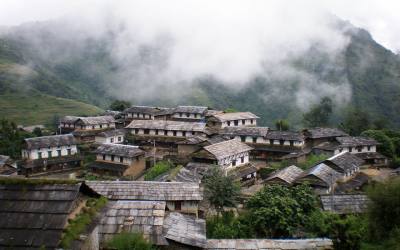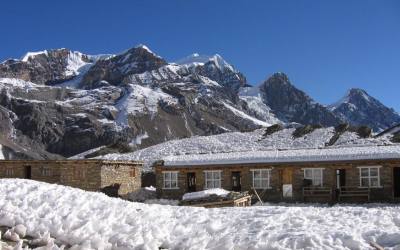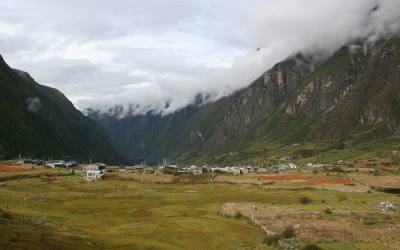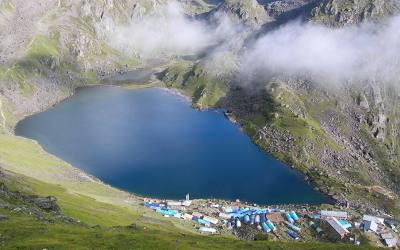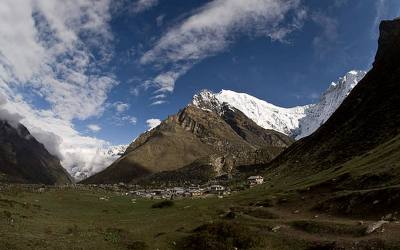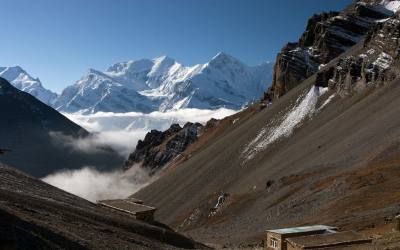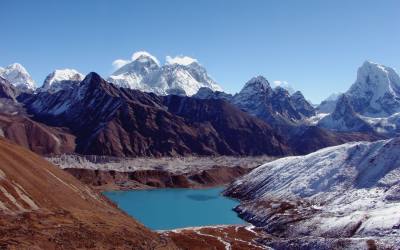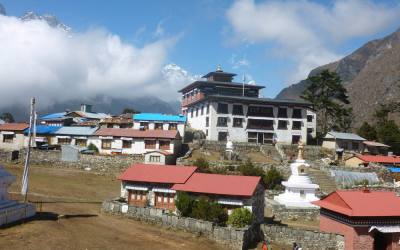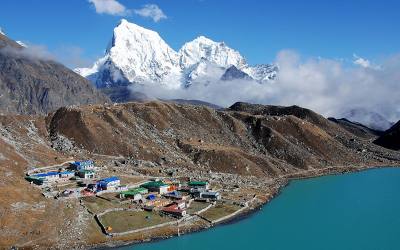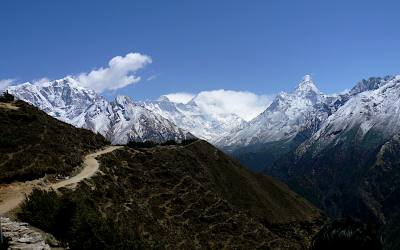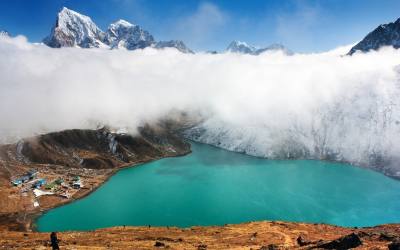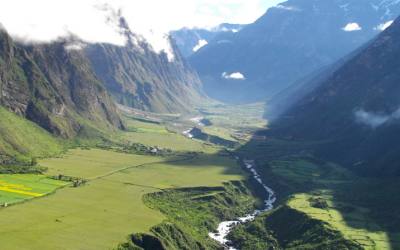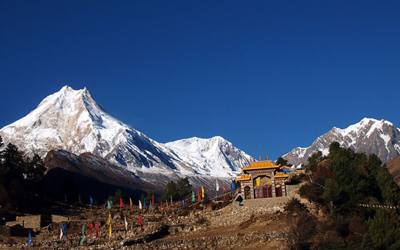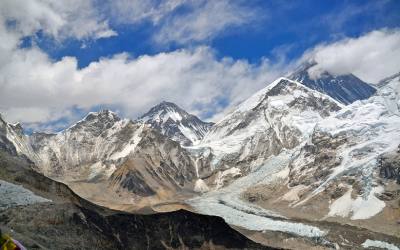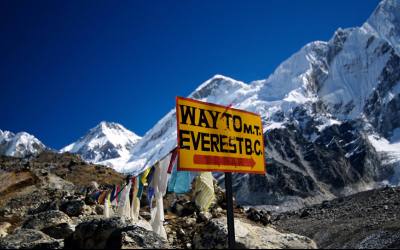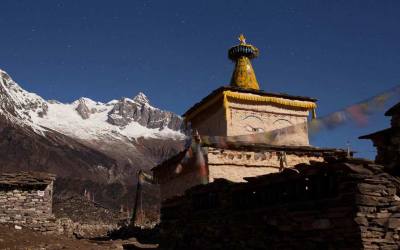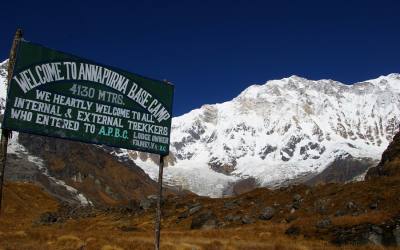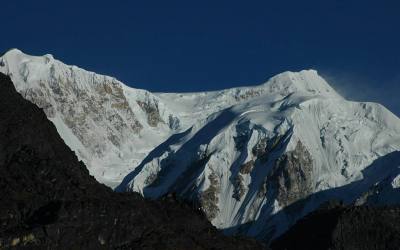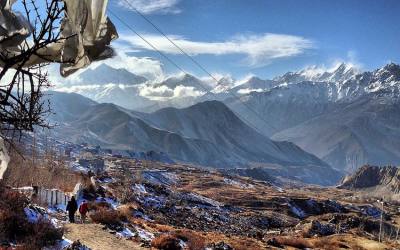The classic walk has clear cut goal to see Mt Everest. Many people find the sights along the way rival the climatic views of the world’s highest mountains Solukhumbhu, the home of legendary sherpas. the northern part of solukhumbu area is encompassed in the Everest national park, which was established to protect the fragile environment of this alpine region. To the east of Everest national park is the Makalu Barun national park, a remote and wild stretch of mountain peaks and deep densely forested valleys. To the west is Rolwaling valley, a well protected microcosm of cultures and ecology. Beside Everest there are three other 8000m peaks Lhotse(8516m) Makalu(8463m), Choyo(8201m)and in addition numerous other peaks of lesser altitude but no less stunning. Add to this glacial lakes, rhododendron forests, native flora and fauna, traditional villages and ancient Buddhist monasteries, all go to make this region a spectacular destination.
People and Culture
Sherpas are main ethnic group who lives around in this region. This is their heart land and their influence is to be seen everywhere from their traditional dress to their distinctive houses and monasteries. There are also minorities of various other groups. Like Rai, Tamang, Braman and Chhetri.
Flora and Fauna
Up to 4000m you will find dense stands of forest including pine, oak and the spectacular flowering rhododendrons. In spring all the hills are riot of colours. There is a good chance of seeing wildlife, mostly of them are birds. If you are lucky, you may will see musk deer, barking deer and Himalayan Tahr.
Day 01: Arrival and transfer to hotel in kathmandu
Day 02: Free day in Kathmandu or self sight seeing around valley (option are)
Mount Everest Flight, Kathmandu Durbar square, Swyambhunath Temple ( Monkey temple), Boudhanath Stupa, Pasupatinath Temple,
Day 03: Kathmandu to Lukla by air then Trek to Phakding ( 2652m) 3-4 hrs of walking
Day 04: Trek to Namche Bazaar (3446m) 6-7 hrs of walking
Day 05: Acclimatization Day at Namche Bazaar ( visiting Everest panorama view or Thami Monastery) 6-7 hrs of walking
Day 06:Trek to Thyangboche Monastery (3875m) 5-6 hrs of walking
Day 07: Trek to Pangboche (4040m) 5-6 hrs of walking
Day 08:Trek to Dingboche (4360m) 5-6 hrs of walking
Day 09: Rest day and Explore to Chukkung valley. 6-7 hrs of walking
Day 10: Trek to Lobuche village. 6-7 hrs of walking
Day 11: Trek to Gorak Shep ( 5160m) leave your baggage at hotel then trek to Everest base camp & return back to Gorakshep. 7-8 hrs of walking
Day 12: Early morning Trek to Kalapathar and Return back to Gorakshep . after breakfast trek to Pheriche(4270m) 7-8 hrs of walking
Day 13: Trek to Namche Bazaar ( 3446m) 7-8 hrs of walking
Day 14: Trek to Lukla( Last night of trekking) 7-8 hrs of walking
Day 15: By air to Kathmandu and at the afternoon self visiting to Patan city
Day 16: Free day in Kathmandu or self sight seeing to Bhaktapur & Chagu Narayan Temple
Day 17: Tour Ends ( Departure for onwards destination)
Youtube Video Link for this Trek
Day 1 – Arrival and transfer to hotel in Kathmandu
Upon arrival in Kathmandu, you are met at the airport and transferred to your hotel. Our airport representative will be waiting for you in the arrival hall, located after passing out of the customs area. Look out for your name in play card out side of arrival hall. The drive from the airport to the hotel is around 20 minutes.
Day02- Free day in Kathmandu or self sight seeing around valley (option are)
Mount Everest flight :It is possible to book a flight to see Mount Everest whilst you are in Kathmandu. The cost is US$ 195.00 (subject to change) per person .
The one hour Everest flight takes off from Kathmandu Airport and flies east where you can see magnificent mountains, including Mount Everest, from a height of around 25,000 feet. You can enjoy a seemingly endless chain of snow capped peaks as you fly above the clouds, over glaciers and lakes, rivers and gorges from your private individual window. This excursion offers a great opportunity to experience and photograph the aerial view of the highest mountain peaks in the world, the Kathmandu valley and the landscapes of Nepal.
Hanumandhoka (Kathamdnu Durbar Square):
It is the historic seat of royalty. The Durbar Square, with its old temples and palaces, epitomizes the religious and cultural life of people. It is here that kings of Nepal are crowned and their coronations solemnized. Interesting things to see here are, Taleju temple built by king Mahendra Malla in 1954 AD, the temple of Kal Bhairab , the god of destruction, Nautale durbar, the statue of King Pratap Malla, the big drum and the Jaganath temple. It was listed in the UNESCO world heritage monument list in 1979.On the right hand corner, a large wooden lattice screen hides an enormous gilded face of Sweta Bhairab. The screen is removed only during the Indra Jatra festival.. there are also the Numismatic museum and Tribhuban museum inside the Hanuman Dhoka palace building . Photography is prohibited inside the museums. Both the mseums remain closed on Tuesday and government holidays.
Swayambunath Temple (Monkey Temple)
The famous Swayambunath Temple is perched on a hill outside Kathmandu and has a square golden stupa rising from a lovely white dome. Monkeys play on the steps up to this temple. Swayambhunath is said to be more than 2000 years old and is a very holy place for Buddhists as well as Hindus. You have a wonderful view over Kathmandu from here.
Boudhanath stupa
It is the largest stupa in Nepal and the holiest Tibetan Buddhist temple outside Tibet. It is the center of Tibetan culture in Kathmandu and rich in Buddhist symbolism. The stupa is located in the town of Boudha, on the eastern outskirts of Kathmandu.
History
Bodnath was probably built in the 14th century after the Mughal invasions; various interesting legends are told regarding the reasons for its construction. After the arrival of thousands of Tibetans following the 1959 Chinese invasion, the temple has become one of the most important centers of Tibetan Buddhism. Today it remains an important place of pilgrimage and meditation for Tibetan Buddhists and local Nepalis, as well as a popular tourist site.
Pashupatinath Temple (Hindu Temple)
Situated 5km east of kathamandu, the temple of Lord Shiva, Pashupatinath, with two tired golden roof and silver door is considered one of the holiest for Hindus. Although only Hindus are allowed inside the temple, visitors can clearly see the temple and the activites performed in the Temple premises from the eastern bank of the Bagmati river. The Temple was listed in the UNESCO world heritage Monument List in 1979
Day 3 - Kathmandu to lukla to Phakding (2652m)
(Trekking: approx 3 hours) In the early morning we take the spectacular flight from Kathmandu to Lukla (2827m), flying parallel to giant Himalayan mountains bordering Nepal and China (Tibet). The flight time is about 40 minutes . After landing we have time to explore the village while our Sherpa crew sort and load our trekking equipment. In the afternoon we begin our trek by descending towards the Dudh Kosi River where we join the main trail to Namche Bazaar, located just above Chaunrikharka (2713m). The walking is easy and after passing through the small village of Ghat (2550m) it is a short walk to Phakding.
Day 4 –Phakding To Namche Bazaar (3446m)
(Trekking: approx 7 hours) From Phakding we cross the river and head up the valley, following porters from the south that are ferrying supplies to Namche Bazaar. The trail keeps close to the river valley and is lined with beautiful blue pine and rhododendron forest that is very spectacular in the spring months, when the flowers are in bloom. We cross the Dudh Kosi River at Benkar, where there are tantalising glimpses of the snow-capped peaks of Kusum Kanguru (6369m) and Thamserku (6623m). From here it is only a short walk to Monjo (2835m), where we arrive in time for lunch. In the afternoon the walking is a little tougher and includes the steep ascent to Namche Bazaar. From Monjo it is a short walk to the entrance of the national park, before we cross the Dudh Kosi River to Jorsale (2805m). The trek continues upstream on generally flat terrain, crossing back to the right bank to the confluence of the Bhote Kosi and Dudh Kosi Rivers, where we start the steep climb to Namche Bazaar. After crossing a large and stable suspension bridge high above the river, we slowly ascend at a steady pace. There are some fantastic photographic opportunities as the peaks of Everest, Lhotse, Nuptse and Taweche (6542m) come into view for the first time.
Day 5 - Namche Bazaar( Acclimatization Day)
We take a steep hike up to Songbuche and then to Everest Panaroma viewpoint (3900 m) from where we will be have great views of Everest, Lhotse, Nuptse,Island Peak Amadablamm Kangde ga, and Thamserku. We also visit Kunde hospital that was erected by Sir Edmund Hilary. Namche – Songbuche – Namche: 6 hrs trek
Day 6- Thyangboche (3875m)
Namche we trek to Khumjung at the foot of sacred Khumbila peak (5,761m). Khumjung Gompa possesses what is said to be the skull of a yeti ! Continue to Phunki and Tyangboche for one of the most magnificent views in the world. Namche – Tyangboche: 5hrs trek There are two routes to Tyangboche and we take the left fork via Khumjung at the foot of Khumbila Peak (5,761m). Khumjung Gompa possesses what is said to be the skull of a yeti. From Khumbila we descend through forest to the village of Trashinga and then down to the Dudh Khosi which can be heard thundering through the valley. After crossing the river it is a long steep climb to Tyangboche. As you reach the top, the incline gradually eases off and you finally pass through a stone gate, built by lamas, which marks the entrance to Tyangboche. In front of you is one of the most impressive views anywhere in the Himalayas, an awe inspiring panorama of Himalayan giants: Kwangde, Tawache, Everest, Nuptse, Lhotse, Amadablam, Kategna and Thamserku. Find yourself a seat and settle down to watch the sun set over Everest!
Day7:Pangboche (4040m)
(Trekking: approx 2 hours) According to legend, Thyangboche Monastery was founded in the 17th century by Lama Sange Dorjee, who came from Tibet’s Rongphu Monastery. Thyangboche was destroyed by an earthquake in 1933, rebuilt and again badly damaged by fire in 1989. Construction of the present monastery was completed in 1992. We spend the first part of morning at Thyangboche to visit the monastery and the nearby museum. There is a small entrance fee for the museum and a small donation to the monastery is appreciated. Later in the morning we descend through alpine forests to the settlement of Deboche, where there is a convent, and then through to Milingo to cross a bridge over Imja Khola. From here the trail gradually climbs up, with great views of Ama Dablam, to the village of Pangboche where we stop for the night. In the afternoon we visit the village of Upper Pangboche.
Day 8 – Dingboche (4360m)
(Trekking: approx 4 hours) Today it is a very pleasant walk, ascending gradually high above the Imja Khola River and passing the tea houses at Orsho before crossing the river and old glacial moraines on our way to our lodge in the settlement of Dingboche. The scenery is spectacular and although Everest here disappears behind the Lhotse-Nuptse ridge, the huge peaks that tower above the eastern end of the valley are ample compensation. We are now almost completely above the tree-line and, in clear conditions, can look out for spectacular sunsets here and on Ama Dablam.
Day 9 – Dingboche ( Rest day and explore)
(Rest and Acclimatisation Day) Dingboche is a beautiful patchwork of small fields enclosed by stone walls protecting the crops of barley and potatoes from the cold winds. It is occupied mainly through the monsoon months, when large numbers of yaks are brought here to graze in the valley pastures. Behind the lodge the huge rock faces of Taweche seem to soar to the heavens. Our trekking guide will advise us on activities for today, but the short excursion up the valley towards Chukkung is a worthwhile option. The views are fantastic in this valley; the towering south face of Lhotse to the north, Island Peak in the centre of the valley and the fluted ice walls of unnamed peaks that line the southern end of the valley.
Day 10 - Lobuche
(Trekking: approx 6½ hours) In the morning we ascend the small ridge behind the village above Pheriche Valley. From the chorten at the top, Taweche and Cholatse (6440m) make for a striking scene as they seem to lean forwards from across the valley in the west. To the north, Lobuje Peak (6119m) and the snowfields of Cho La dominate the skyline. The walking is now generally fairly flat on wide-open fields, but do take your time and ensure you are well hydrated. Late in the morning we cross the Khumbu Khola at Dughla (4620m) and take a light lunch at the foot of the huge terminal moraines of Khumbu Glacier, which flows off Everest. In the afternoon, there is a solid and quite steep climb on a rocky trail to the top of the moraines. On the crest of the ridge, we pass a line of memorial cairns, built in memory of Sherpas and other climbers who have died on the various Everest expeditions over the last 50 years. From here the view is spectacular - Pumori (7145m) and, across the border in Tibet, Changtse (7550m), are seen at the head of the valley whilst Everest remains hidden behind the towering walls of Nuptse and Lhotse.
Day 11 - Gorak Shep (5160m) - Everest Base Camp
(Trekking: approx 3 hours to Gorak Shep, 5 hours round trip to Everest Base Camp) As the trek to Gorak Shep is relatively short, we have the opportunity for a leisurely breakfast before beginning the day’s walk. From Lobuche we follow the broad valley that runs parallel to Khumbu Glacier. A gradual ascent enables us to build the slow, steady rhythm required when walking at high altitude. When we reach the moraines of Changri Nup Glacier, we make a series of small ascents and descents over a rocky trail lined with cairns that leads eventually to the surprising glacial sands of Gorak Shep (5160m) - reached after about three hours of walking. After a quick bite we gear up accordingly to head off towards the Everest Base Camp. The trek to the base camp can be achieved in around three hours and if trekking in the popular climbing period of March to May, we will almost certainly encounter yaks and porters supplying food and equipment to expeditions here. From Everest Base Camp we do not get views of Mount Everest, but we are able to see the notorious Everest Ice Fall that flows from the Western Cwm, which is regarded as technically the hardest and most dangerous section of the mountain. The return journey from the Base Camp to Gorak Shep takes the same amount of time. We have an early dinner so that we are able to get up early the next day for awe-inspiring views of the Himalayan giants from Kala Patar.
Day 12 - Kala Patar - Pheriche (4270m)
(Trekking: approx 8 hours) We wake up early the next day for the trek to Kala Patar (5643m) to experience sensational sunrise views from this amazing vantage point. From the lodge the ascent is quite steep, so start very slowly and try to ascend at a steady rhythmic pace. Kala Patar is the rocky hilltop below Pumori. It is a tough walk because of the altitude, but the view from the top surpasses the wildest imagination. It will probably take a good hour and a half to reach the summit from Gorak Shep, although lower viewpoints can provide views that are almost as good. Pumori, Nuptse, Changtse, Ama Dablam, Taweche, Kantega and Everest, the highest mountain in the world, surround us. About three kilometres away and some 200 metres below, the area of the Everest Base Camp can be seen in a bowl at the bottom of the Khumbu Ice Fall. For many trekkers, reaching Kala Patar is a very emotional experience and it is worthwhile spending as long as you wish in order to savour this special moment. The descent back down to Gorak Shep is easy and once back at the lodge we have a quick drink and head off to the rooms to pack our kit bags whilst breakfast is being prepared. After breakfast we set off to Lobuche and Thugla, where we stop for lunch. After lunch we cross the Khumbu Khola and head down the valley below Cholatse to Pheriche, where we stop for the night
Day 13 - Namche Bazaar (3446m)
(Trekking: approx 6 hours) From Pheriche we cross the Khumbu Khola River and ascend a short steep trail to the top of a small ridge for great views of Imja Valley, Ama Dablam and Kantega. We then descend to the small settlements at Orsho and Shomare before passing through Lower Pangboche to reach the suspension bridge over the Imja Khola River to ascend back to Thyangboche for lunch. In the afternoon we descend steeply through beautiful forest of juniper, rhododendron and fir to Phunkitenga. After a welcome break and perhaps a cup of tea we cross the Dudh Kosi river and ascend to Trashinga. From here the trail contours high above the valley through Shanasa and on to Namche Bazaar where we spend the night.
Day 14 –Via Phakding to Lukla
(Trekking: approx 7 hours) We enjoy a leisurely departure from Namche Bazaar with a final opportunity to visit the shops in the bazaar before we descend steeply down to the large suspension bridge over the Dudh Kosi River. We follow the trail through Jorsale and back to Monjo, where we take lunch. In the afternoon it is a short walk via Benkar through blue pine and rhododendron forest, with great views of Kusum Kangaru, back to lodge in Lukla.
Day 15 – To Kathmandu by air and at the afternoon self visiting around valley
Patan
The ancient city of Patan, lying 5 km southwest of kathmandu, is known as the city of fine arts, The city is full of Hindu temples and Buddhist monuments. The diversity of the medieval culture that allowed both Hinduism and Buddhism to flourish has left a rich legacy of impressive sightseeing in this city for today’s visitors.
Patan Durbar Square
Situated in the heart of the city, constitutes the focus of visitor’s attraction. The square is full of ancient palaces, Temple and shrines, noted for their exquisite carvings. The Patan durbar Square consist of three main chowks or countryards, the Central Mul Chowk, Sundari Chowk and Keshar narayan Chowk, The Sundari Chowk holds in its center a masterpiece of stone architecture. The Royal Bath called Tushahity. It was listed in the UNESCO world Heritage Monument list in 1979.
Day 16 - Free day in Kathmandu or self visiting to Bhaktapur city
Bhaktapur
Situated at an altitude of 1,401m, Bhaktapur covers an area of four square miles. Bhaktapur or the city of Devotees still retains a medieval charm and visitors to this ancient town are treated to myriad wonders of cultural and artistic achievements. The past glory of the Malla rulers continues to be reflected at the Durbar Square. Pottery and weaving are its traditional industries. Bhaktapur is famous for woodcarving and the Bhadgaolen topi or cap. The city lies about 14 km east of Kathmandu and can be reached by public transport .
Bhaktapur durbar Squares:
The Golden Gate is the entrance to the main courtyard of the Palace of 55 Windows.Built by King Ranjit Malla. The gate is one of the most beautiful and richly carved specimens of its kind in the entire world. This gate is embellished with deities and monsters with marvelous intricacy. The palace of 55 windows was built in 1700 AD. Among the brick walls in their gracious setting and sculptural design, is a balcony of 55 windows. This balcony is a masterpiece of wood carving. The stone temple of Batsala Devi which is also located in the Durbar Square is full of intricate carvings. This temple also sets a beautiful example of Shikhara style architecture in Nepal. There is a bronze bell on the terrace of the temple which is also known as the Bell of Barking Dogs.This colossal bell, placed in 1737 AD, was rung to signal curfew those days.
The main square of the city contains innumerable temples and other architectural showpieces like the Lion Gate, the statue of King Bhupatindra Malla, the Picture Galley, the Batsal Temple, etc. A magnificent statue of King Bhupatindra Malla in the act of worship is placed on the column facing the palace. It was listed in the UNESCO World Heritage Monument list in 1979.
Changu Narayan:
Situated at the end of a long ridge which runs well into the Valley, It is said to have been built by king Hari Dutta in 323 AD said to be the oldest temple in the valley. It was listed in the UNESCO world Heritage Mountain list in 1979.
Day17: Tour Ends (Departure for onwards destination)
Youtube Video Link for this Trek
https://www.youtube.com/watch?v=jA0WofezWZU
or
https://www.youtube.com/watch?v=O8L8fFydhX4
Price Per Person US$ 1050.00 (Price are based on standard class hotel)
Price for meals and drinks during the trek Allow US$ 25.00 per person per day for trekking (off-course you are going to pay every day directly by yourself to the tea houses during the trek.it is just a guideline)
Single supplement US$ 150.00 per person ( you will get single room in kathmandu and during the trek. you can book your trekking tour as a solo with us. in this case we will charge little higher)
Additional night in kathmandu will cost US$ 40.00 for Double room with Bed and Breakfast and US$ 35.00 for single room.
Trekking prices with out hotel in kathmandu will cost US$ 975.00 per person.
Off-course it is always possible to upgrade the hotel in kathmandu according to your budget and interest. But it will cost you extra and you need to pay the differences.
Hotel we use
Kathmandu Prince Hotel (standard class hotel)
Website : www.kathmanduprincehotel.com
Or
Potala Guest House (Standard class hotel)
Website : www.potalaguesthouse.com
Or
Hotel Marsyandi Mandala (Standard class hotel)
http://www.marsyangdimandala.com
Delux class hotel
Hotel Manasulu (3star)
Website: www.hotelmanaslu.com
Grand Hotel Kathmandu (4star)
http://www.grandhotelnepal.com
Hotel Manang Pvt. Ltd (3star)
http://www.hotelmanang.com
Hotel Yellow pagoda (4 star)
[email protected]
www.yellowpagoda.com
Radission hotel kathmandu (5star)
https://www.radisson.com/kathmandu-hotel-np/nepkathm
Hotel Yak & Yeti (5star)
http://www.yakandyeti.com/
Note: As per our company rule to confirm your booking with us we do need photo copy of your passport, one passport size photo graph, international flight details (Date of arrival , date of departure ,flight number ) and 15% of total amount as a down payment. Rest remaining other amount you can pay to us upon your arrival in kathmandu. Once you agreed to booking with us then we can provide you our bank details to make wire transfer or you can also pay by major credit cards such as visa, Master or by American express. in this case you need to send us copy of your credit cards. But it will cost you 5% extra because it is the rule of our local bank.
Note: If some one who is willing to book their trekking tour as a private then the tour will departure everyday.
What’s Included
- Airport Pickup and Drop by private transport (Only for Domestic and international flight)
- 4 night hotel in Kathmandu with Bed and Breakfast (Centrally located ,Room with attach bathroom and hot and cold shower)
- 12 nights 13 days trekking in lodges(Lodges are Simple but clean enough and has a hot and cold shower)
- Everest National Park fee with TIMS(Trekking management information system) we need two photograph each for permit.
- Pasang lamu village development ticket
- one experience Trekking guide (trained by Ministry of tourism), one trekking porter between every two person (Our trekking porter he will carry maximum 20-22 k.g of baggage) and their meal/accommodation/transportation/salary/insurance/equipments are included in price.
- Domestic Airfare (Kathmandu to Lukla, Lukla to Kathmandu and domestic airport tax)
- Airfare for trekking guide
- Trekking map for Everest Region
- First aid kit box
- light crampoons for trekking in the month of late november, December, Jan, Feb, early March
- Sleeping bag for Trekking
- All the govt tax
What’s not Included
- Personal bar bill, travel insurance/International airfare.
- Items of personal expenses such as alcoholic drinks, cold drinks, laundry, tips etc.
- Nepal entry visa fee US$ 40 (duration 30 days from date of issue)- Available at Royal Nepalese Embassies and Royal Nepalese Consulates abroad or on arrival at Tribhuvan International Airport in Kathmandu.
- Sight seeing in Kathmandu valley and All the entrance fees of temple in Kathmandu valley
- All the meals and drinks during the trek Breakfast, Lunch , Dinner, Tea and coffee (Allow US$ 25 per person per day for trekking)
- Tips for trekking guide and trekking porter
- Hot shower during the trek (it will cost US$ 4per shower)
Essential Info
Trip Map
Departure Dates
Note: If someone who like to travel as a individual the trip will departure every day.
Note
We will offer special rates for Tour Operater and Wholeseller.
